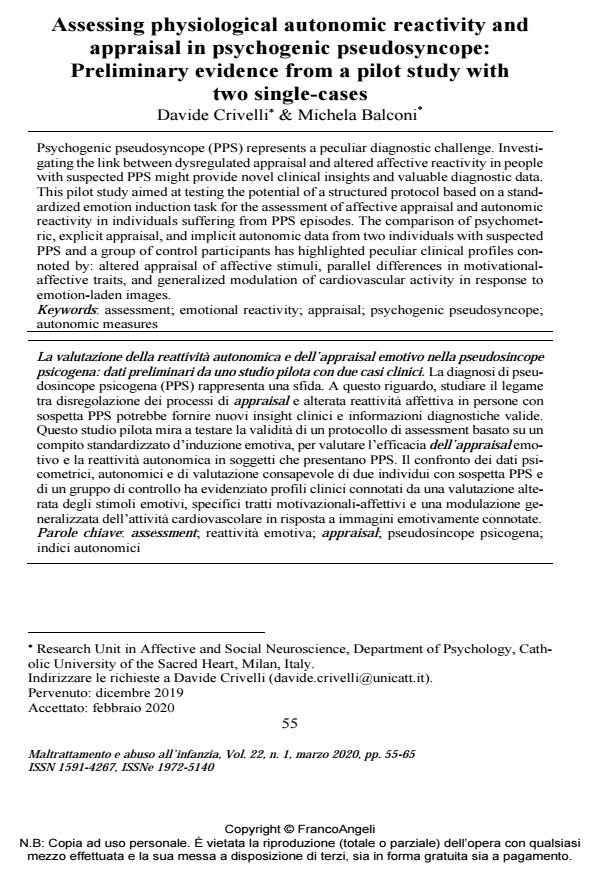Assessing physiological autonomic reactivity and appraisal in psychogenic pseudosyncope: Preliminary evidence from a pilot study with two single-cases
Journal title MALTRATTAMENTO E ABUSO ALL’INFANZIA
Author/s Davide Crivelli, Michela Balconi
Publishing Year 2020 Issue 2020/1
Language English Pages 11 P. 55-65 File size 183 KB
DOI 10.3280/MAL2020-001005
DOI is like a bar code for intellectual property: to have more infomation
click here
Below, you can see the article first page
If you want to buy this article in PDF format, you can do it, following the instructions to buy download credits

FrancoAngeli is member of Publishers International Linking Association, Inc (PILA), a not-for-profit association which run the CrossRef service enabling links to and from online scholarly content.
Psychogenic pseudosyncope (PPS) represents a peculiar diagnostic challenge. Investigating the link between dysregulated appraisal and altered affective reactivity in people with suspected PPS might provide novel clinical insights and valuable diagnostic data. This pilot study aimed at testing the potential of a structured protocol based on a standardized emotion induction task for the assessment of affective appraisal and autonomic reactivity in individuals suffering from PPS episodes. The comparison of psychometric, explicit appraisal, and implicit autonomic data from two individuals with suspected PPS and a group of control participants has highlighted peculiar clinical profiles connoted by: altered appraisal of affective stimuli, parallel differences in motivational-affective traits, and generalized modulation of cardiovascular activity in response to emotion-laden images.
Keywords: Assessment; emotional reactivity; appraisal; psychogenic pseudosyncope; autonomic measures
- Neurofeedback as neuroempowerment technique for affective regulation and interoceptive awareness in adolescence: preliminary considerations applied to a psychogenic pseudosyncope case Michela Balconi, Laura Angioletti, Davide Crivelli, in Frontiers in Rehabilitation Sciences 1056972/2023
DOI: 10.3389/fresc.2023.1056972 - Electrophysiological signature of interoceptive attention: a spectral and source localization analysis Davide Crivelli, Michela Balconi, in Cognitive, Affective, & Behavioral Neuroscience /2025 pp.402
DOI: 10.3758/s13415-024-01235-3
Davide Crivelli, Michela Balconi, Assessing physiological autonomic reactivity and appraisal in psychogenic pseudosyncope: Preliminary evidence from a pilot study with two single-cases in "MALTRATTAMENTO E ABUSO ALL’INFANZIA" 1/2020, pp 55-65, DOI: 10.3280/MAL2020-001005